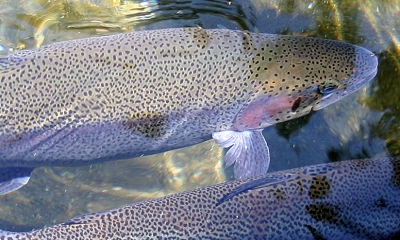
Trout
Trout is Oregon's number one game fish. From one end of the state to the other, anglers will find native populations of rainbow, cutthroat and other species of trout. In addition to the native populations, ODFW stocks over 5 million trout each year to provide even more opportunity. As a result, there's good trout fishing somewhere in Oregon 365 days a year.

Types of Trout

Features: Brook trout are easily identified by the worm-like pale yellow markings on their backs and red dots with blue halos and white borders on their lower fins. In small streams brook trout are often 5- to 7-inches long but can reach 25 inches or more in large rivers or lakes.
Habitat: Brook trout are an introduced species, first stocked in the early 1900s. They are widely distributed from high mountain lakes to headwater tributaries, and thrive in cold, mountainous streams and lakes where other species are unable to do well. Many barren lakes have been stocked with brook trout, providing fishing opportunity where none was previously available.
Techniques: Because insect larvae and nymphs make up a large part of brook trouts' diet (especially when the fish are small), they are a favorite of fly-fishers who use flies mimicking these insects. However, brook trout are aggressive biters and will go after a variety of bait and lures.

Features: The coloration tends to be golden-brownish with dark brown or black spots on the body, and on the dorsal and adipose fins. Usually few or no spots appear on the tail fin. Many body spots, especially those below the lateral line, are edged with pink, red, or orange, forming rings or halos. Breeding males develop strong teeth and a hooked snout. Size can range from 11-inches long in small streams to over 30-inches in large rivers or lakes.
Habitat: Although brown trout can adapt themselves to sluggish streams and warmer temperatures than other trout, cold, spring-fed tributary streams with stable water conditions are required for successful spawning.
Techniques: The brown is known as the wariest of trout and the most difficult to catch. While brown trout have a varied diet, anglers often target them use spinners or flies that mimic minnows. As the current carries the bait down river, hold as much fishing line off the water as you can to achieve a natural “drift.” Once the line has swung toward the shore and is straight down river, begin a moderate retrieve.

Features: While their coloration can be variable, bull trout are generally gray infused with green. The body is covered with small white or pale yellow spots. Some spots along the side may be deep orange to red. The leading edges of the fins along their bellies are white. Bull trout, despite the common name, is not actually a trout but a member of the closely related char group.
Habitat: Bull trout require cold, clean water to survive and are typically found in the headwaters of Oregon rivers. Spawning occurs in the fall when water temperatures drop below 50F.
Techniques: Anglers can fish specifically for bull trout in the Imnaha, Wenaha, and Metolius Rivers and Lake Billy Chinook. Please follow ODFW regulations specific to each waterbody. Bull trout are voracious predators of other fish, so anglers often use lures or flies mimicking large minnows or small fish.

Features: The lake trout is not particularly colorful – usually gray with large pale spots – and can be distinguished from other trout by its deeply-forked tail. Lake trout, despite the common name, is not actually a trout but a member of the closely related char group. They can reach weights of 20 pounds.
Habitat: These aggressive, fish-eating char are popular sport fish found in deep, cold water with plenty of oxygen and proper spawning areas. There also must be abundant forage fishes for them to eat.
Techniques: Many anglers target lake trout in the spring, when they hang out closer to the surface. At other times of the year, anglers troll in deep, cool waters to find lake trout.

Features: Tiger trout are a hybrid between a female brown trout and a male brook trout. They are greenish yellow to brown with dark patches along their sides creating a maze-like pattern. Their belly is yellowish orange and the tail fin is square.
Habitat: These sterile fish have been introduced to Diamond and Fish lakes to help combat several invasive bait fish species. Since they do not reproduce, tiger trout are catch-and-release only.
Techniques: Tiger trout will go for flies, spoons, spinners and bait. Because tiger trout are piscivorous (they eat other fish), fishing a minnow imitation can be effective.



